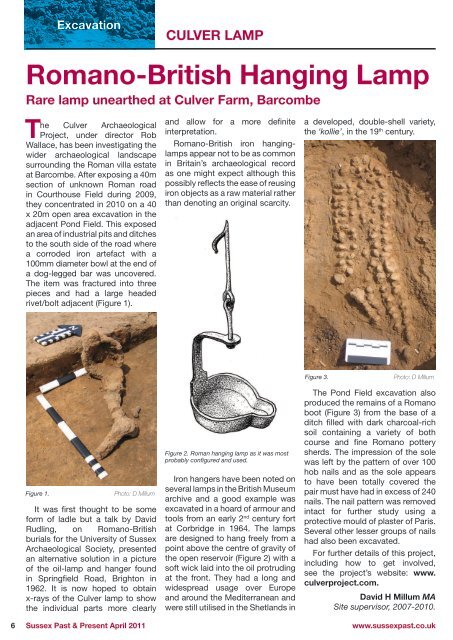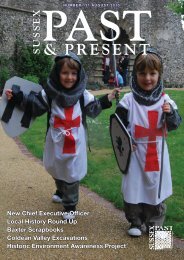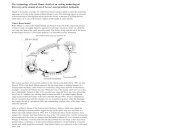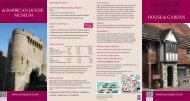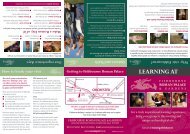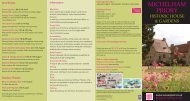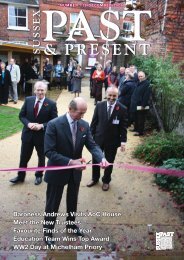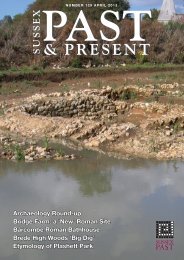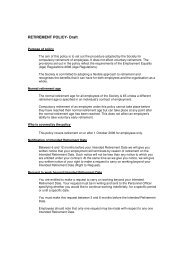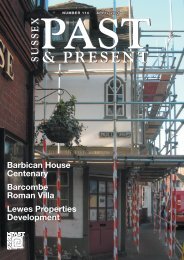April 2011 (issue 123) - The Sussex Archaeological Society
April 2011 (issue 123) - The Sussex Archaeological Society
April 2011 (issue 123) - The Sussex Archaeological Society
You also want an ePaper? Increase the reach of your titles
YUMPU automatically turns print PDFs into web optimized ePapers that Google loves.
Excavation<br />
CULVER LAMP<br />
SDNPA<br />
Feature<br />
Romano-British Hanging Lamp<br />
Rare lamp unearthed at Culver Farm, Barcombe<br />
<strong>The</strong> Culver <strong>Archaeological</strong><br />
Project, under director Rob<br />
Wallace, has been investigating the<br />
wider archaeological landscape<br />
surrounding the Roman villa estate<br />
at Barcombe. After exposing a 40m<br />
section of unknown Roman road<br />
in Courthouse Field during 2009,<br />
they concentrated in 2010 on a 40<br />
x 20m open area excavation in the<br />
adjacent Pond Field. This exposed<br />
an area of industrial pits and ditches<br />
to the south side of the road where<br />
a corroded iron artefact with a<br />
100mm diameter bowl at the end of<br />
a dog-legged bar was uncovered.<br />
<strong>The</strong> item was fractured into three<br />
pieces and had a large headed<br />
rivet/bolt adjacent (Figure 1).<br />
Figure 1.<br />
Photo: D Millum<br />
It was first thought to be some<br />
form of ladle but a talk by David<br />
Rudling, on Romano-British<br />
burials for the University of <strong>Sussex</strong><br />
<strong>Archaeological</strong> <strong>Society</strong>, presented<br />
an alternative solution in a picture<br />
of the oil-lamp and hanger found<br />
in Springfield Road, Brighton in<br />
1962. It is now hoped to obtain<br />
x-rays of the Culver lamp to show<br />
the individual parts more clearly<br />
and allow for a more definite<br />
interpretation.<br />
Romano-British iron hanginglamps<br />
appear not to be as common<br />
in Britain’s archaeological record<br />
as one might expect although this<br />
possibly reflects the ease of reusing<br />
iron objects as a raw material rather<br />
than denoting an original scarcity.<br />
Figure 2. Roman hanging lamp as it was most<br />
probably configured and used.<br />
Iron hangers have been noted on<br />
several lamps in the British Museum<br />
archive and a good example was<br />
excavated in a hoard of armour and<br />
tools from an early 2 nd century fort<br />
at Corbridge in 1964. <strong>The</strong> lamps<br />
are designed to hang freely from a<br />
point above the centre of gravity of<br />
the open reservoir (Figure 2) with a<br />
soft wick laid into the oil protruding<br />
at the front. <strong>The</strong>y had a long and<br />
widespread usage over Europe<br />
and around the Mediterranean and<br />
were still utilised in the Shetlands in<br />
a developed, double-shell variety,<br />
the ‘kollie’, in the 19 th century.<br />
Figure 3.<br />
Photo: D Millum<br />
<strong>The</strong> Pond Field excavation also<br />
produced the remains of a Romano<br />
boot (Figure 3) from the base of a<br />
ditch filled with dark charcoal-rich<br />
soil containing a variety of both<br />
course and fine Romano pottery<br />
sherds. <strong>The</strong> impression of the sole<br />
was left by the pattern of over 100<br />
hob nails and as the sole appears<br />
to have been totally covered the<br />
pair must have had in excess of 240<br />
nails. <strong>The</strong> nail pattern was removed<br />
intact for further study using a<br />
protective mould of plaster of Paris.<br />
Several other lesser groups of nails<br />
had also been excavated.<br />
For further details of this project,<br />
including how to get involved,<br />
see the project’s website: www.<br />
culverproject.com.<br />
David H Millum MA<br />
Site supervisor, 2007-2010.<br />
Finally after over 50 years of<br />
campaigning and a decade<br />
of negotiation, the new South<br />
Downs National Park will become<br />
operational on 1 st <strong>April</strong> <strong>2011</strong>. This<br />
is a major achievement, and one<br />
which will do much to protect the<br />
archaeology and heritage of this<br />
exceptional landscape.<br />
Stretching almost 100 miles from<br />
Winchester to Eastbourne, and<br />
covering an area of approximately<br />
1000 square miles, the South<br />
Downs National Park includes<br />
evidence of human activity from<br />
the Palaeolithic to the present day.<br />
<strong>The</strong>re are nearly 600 Scheduled<br />
Monuments, over 5,000 Listed<br />
Buildings, about 165 Conservation<br />
Areas and 30 Registered Parks and<br />
Gardens, not to mention thousands<br />
of undesignated archaeological<br />
and historical features. <strong>The</strong> park<br />
also includes a number of market<br />
towns – Lewes, Midhurst, Petworth,<br />
Petersfield and Liss – which are<br />
rich in history and character. <strong>The</strong><br />
breadth and complexity of this<br />
historic environment is staggering.<br />
<strong>The</strong> conservation of cultural<br />
heritage is one of the primary<br />
purposes of the National Park.<br />
In order to achieve this, the new<br />
Authority has been active in<br />
structuring an organisation that can<br />
meet the challenges of conservation<br />
within the 21 st century. Under the<br />
leadership of Margaret Paren (Chair)<br />
and Richard Shaw (Chief Executive),<br />
the new Authority is starting to take<br />
shape and has been very active in<br />
consulting its partners in preparing<br />
a set of ‘guiding principles’ which<br />
will shape the future direction of<br />
the park (available on-line at www.<br />
southdowns.gov.uk). <strong>The</strong> next<br />
step is establishing a number of<br />
working groups who will shape our<br />
vision for the future.<br />
What Future for the Past?<br />
Conserving cultural heritage within the SDNP<br />
Distant view of <strong>The</strong> Caburn, an Iron Age ‘hillfort’ on the Lewes downs.<br />
It has also wrestled with the<br />
weighty problem of how to meet its<br />
statutory duty as the Local Planning<br />
Authority for the National Park and<br />
has decided to adopt a planning<br />
system where much of the work is<br />
done, by agreement, by constituent<br />
Local Councils, while the Authority<br />
undertakes the park-wide strategic<br />
planning and major casework.<br />
<strong>The</strong> National Park is likely to be<br />
the busiest, in terms of planning<br />
workload, of any in the UK and this<br />
approach is intended to ensure that<br />
the weight of planning work does<br />
not deflect the Authority from its<br />
wider conservation, engagement<br />
and socio-economic purposes. A<br />
report outlining how this will work<br />
is also available on the website.<br />
Over the coming years, the<br />
Authority will need to understand<br />
and act on the key heritage <strong>issue</strong>s,<br />
and it will look to partners such as<br />
the <strong>Society</strong> for help in doing this. A<br />
new cultural heritage team is now<br />
in place to lead on this, based in<br />
our office in Midhurst. <strong>The</strong> main<br />
heritage tasks for the first few years<br />
include i) developing a Management<br />
Plan for the South Downs to ensure<br />
that appropriate priority is given<br />
to heritage interests, ii) preparing<br />
Photo: W Muriel<br />
a Local Development Framework<br />
to reflect the management plan<br />
priorities, iii) agreeing a way to<br />
draw on existing county and district<br />
Historic Environment Records, and<br />
iv) how best to work with local<br />
groups and communities in caring<br />
for, and learning from, our heritage.<br />
But the Authority can’t do this<br />
alone - in deciding on how best<br />
to act to conserve and enhance<br />
the cultural heritage of the South<br />
Downs, it will work with others to<br />
build on the excellent conservation,<br />
land management, research and<br />
educational work that is already<br />
being done.<br />
Conserving and enhancing the<br />
“natural beauty” of the South<br />
Downs landscape and promoting<br />
understanding and enjoyment<br />
of its special qualities will be<br />
the Authority’s touchstones,<br />
and we would suggest that, as<br />
archaeologists and historians, it<br />
is our role to help explain how<br />
the natural beauty of the South<br />
Downs has been influenced by<br />
people through the ages and how<br />
the legacy of that endeavour is<br />
ingrained in the landscape today.<br />
Paul Roberts<br />
Regional Rural Strategy Advisor<br />
English Heritage<br />
<strong>Sussex</strong> Past & Present <strong>April</strong> <strong>2011</strong><br />
www.sussexpast.co.uk www.romansinsussex.co.uk <strong>Sussex</strong> Past & Present <strong>April</strong> <strong>2011</strong>


